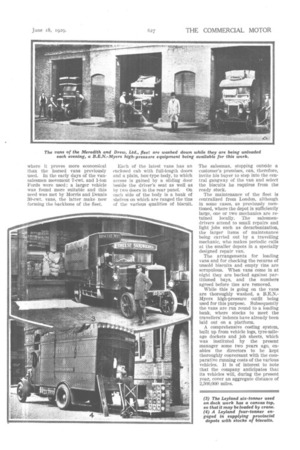ISCUIT DISTRI VUTION Y MO I ORVAN
Page 98

Page 99

If you've noticed an error in this article please click here to report it so we can fix it.
THE distribution of biscuits from a central factory in London to practically every town in England, and the maintenance of supplies in all important districts of the kinds of biscuit which are from time to time in favour, involves a transport organization of considerable size and, above all, mobility. Meredith and Drew, Ltd., has one large factory in the east of London and from this distributes, through 23 provincial depots, to all parts of the country. A great expansion to business has resulted from the adoption, in 1919, of commercial motors as a means for .conveyance, and especially with the development of a system of employing salesmendrivers, who travel the country and sell biscuits to small retailers for immediate delivery against cash.
Commencing 10 years ago with six Ford vans, the company has gradually acquired a fleet of 180 vehicles, which mainly consist of three classes: heavy lorries for delivery in bulk to the local centres, light delivery vans for the salesmen-drivers referred to above and private cars for those salesmen who call upon the more important wholesale customers. As, however, the bulk of the business is done with the licensed and refreshment trades, the van-salesman becomes the most important distributing medium, and the operation and maintenance of the many 30cwt. vehicles employed calls for the most scrupulous management.
The 23 depots which act as centres for the salesmen are, at the same time, stores for the biscuit supplies and maintenance depots for the vehicles. They range from subdepots, as at Southend, controlled by one man, to large depots, like that at Leeds, each having a manager and a staff of mechanics. The depots are supplied from the factory at Shadwell by heavy lorries operating on definite routes at specified times. These comprise five Leyland type GH2 4-tonuers and one 6-tonner, two Leyland-Carriraore six-wheeler 8tonners and one Karrier DD6/1type vehicle.
In addition to these, a Leyland 6tonner is employed on dock haulage, where it proves more economical than the horsed vans previously used. In the early days of the vansalesmen movement 7-cwt. and 1-ton Fords were used; a larger vehicle was found more suitable and this need was met by Morris and Dennis 30-ewt. vans, the latter make now forming the backbone of the fleet. Each of the latest vans has an enclosed cab with full-length doors and a plain, box-type body, to which access is gained by a sliding door beside the driver's seat as well as by two doors in the rear panel. On each side of the body is a bank of shelves on which are ranged the tins of the various qualities of biscuit. The salesman, stopping outside a customer's premises, can, therefore, invite his buyer to step into the central gangway of the van and select the biscuits he requires from the ready stock.
The maintenance of the fleet is centralized from London, although in some cases, as previously mentioned, where the depot is sufficiently large, one or two mechanics are retained locally. The salesmendrivers attend to small repairs and light jobs such as decarbonization, the larger items of maintenance being carried out by a travelling mechanic, who makes periodic calls at the smaller depots in a specially designed repair van.
The arrangements for loading vans and for checking the returns of unsold biscuits and empty tins are scrupulous. When vans come in at night they are backed against partitioned bays, and the numbers agreed before tins are removed.
While this is going on the vans are thoroughly washed, a B.E.N.Myers high-pressure outfit being used for this purpose. Subsequently the vans are run round to a loading bank, where stocks to meet the travellers' indents have already been laid out on a platform.
A comprehensive casting system, built up from vehicle logs, tyre-mileage dockets and job sheets, which was instituted by the present manager some two years ago, enables the directors to be kept thoroughly conversant with the comparative running costs of the various vehicles. It is of interest to note that the company anticipates that its vehicles will, during the present year, cover an aggregate distance of 2,500,000 miles.








































































































































































































